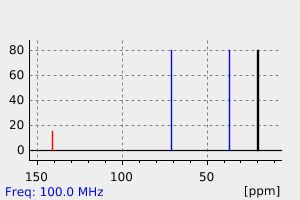(1-氯-2-甲基丙基)苯 | 936-26-5
中文名称
(1-氯-2-甲基丙基)苯
中文别名
——
英文名称
(1-chloro-2-methylpropyl)benzene
英文别名
1-Chlor-2-methyl-1-phenylpropan;rac-1-chloro-2-methyl-1-phenylpropane;1-Chlor-1-phenyl-isobutan
CAS
936-26-5
化学式
C10H13Cl
mdl
——
分子量
168.666
InChiKey
DVMSSEGSXWICNT-UHFFFAOYSA-N
BEILSTEIN
——
EINECS
——
-
物化性质
-
计算性质
-
ADMET
-
安全信息
-
SDS
-
制备方法与用途
-
上下游信息
-
文献信息
-
表征谱图
-
同类化合物
-
相关功能分类
-
相关结构分类
计算性质
-
辛醇/水分配系数(LogP):3.7
-
重原子数:11
-
可旋转键数:2
-
环数:1.0
-
sp3杂化的碳原子比例:0.4
-
拓扑面积:0
-
氢给体数:0
-
氢受体数:0
SDS
上下游信息
-
上游原料
中文名称 英文名称 CAS号 化学式 分子量 异丁基苯 1-phenyl-2-methylpropane 538-93-2 C10H14 134.221
反应信息
-
作为反应物:描述:(1-氯-2-甲基丙基)苯 在 三乙胺 作用下, 以 乙醇 、 二氯甲烷 为溶剂, 反应 4.0h, 生成 3-cyanophenyl 4-(2-methyl-1-phenylpropyl)piperazine-1-carboxylate参考文献:名称:用于治疗青光眼的有效和选择性 MGL 抑制剂的合成和评估。摘要:单酰基甘油脂肪酶 (MGL) 抑制通过调节眼部 2-花生四烯酸甘油 (2-AG) 水平和激活 CB1 受体,为青光眼提供了一种潜在的治疗方法。在此,我们报告发现了新系列的氨基甲酸酯作为高效和选择性的 MGL 抑制剂。新抑制剂对重组人和纯化的大鼠 MGL 显示出有效的纳摩尔抑制活性,对丝氨酸水解酶 FAAH 和 ABHD6 具有选择性(> 1000 倍),并且对大麻素受体 CB1 和 CB2 没有任何亲和力。基于蛋白质的1 H NMR 实验表明抑制剂2与 MGL 迅速形成共价加合物,停留时间约为 6 小时。通过修改配体的大小(长度和体积)来利用这种相互转化过程“内在可逆性”来生成具有“可调”加合物停留时间 (τ) 的类似物。在血压正常的小鼠模型中对抑制剂2进行评估,以评估眼内压 (IOP),这可能导致青光眼,这是导致失明的主要原因。发现抑制剂2在单次眼部应用后至少 12 小时内以持续方式将眼压降低约DOI:10.1016/j.bmc.2018.11.003
-
作为产物:参考文献:名称:平衡芳基羰基和甲醇选择性脱氧卤化的路易斯酸度和碳正离子稳定性摘要:利用适当的金属卤化物路易斯酸作为羰基活化剂和卤素载体,并结合硼烷-氨作为还原剂,实现了芳基醛、酮、羧酸和酯的脱氧卤化。通过将碳阳离子中间体的稳定性与路易斯酸的有效酸度相匹配来实现选择性。取代基和取代模式显着影响所需的溶剂/路易斯酸组合。这些因素的逻辑组合也已应用于醇向烷基卤的区域选择性转化。DOI:10.1021/acs.orglett.3c01462
文献信息
-
Nucleophilic Substitutions of Alcohols in High Levels of Catalytic Efficiency作者:Tanja Stach、Julia Dräger、Peter H. HuyDOI:10.1021/acs.orglett.8b01023日期:2018.5.18A practical method for the nucleophilic substitution (SN) of alcohols furnishing alkyl chlorides, bromides, and iodides under stereochemical inversion in high catalytic efficacy is introduced. The fusion of diethylcyclopropenone as a simple Lewis base organocatalyst and benzoyl chloride as a reagent allows notable turnover numbers up to 100. Moreover, the use of plain acetyl chloride as a stoichiometric
-
A General Catalytic Method for Highly Cost‐ and Atom‐Efficient Nucleophilic Substitutions作者:Peter H. Huy、Isabel FilbrichDOI:10.1002/chem.201800588日期:2018.5.23A general formamide‐catalyzed protocol for the efficient transformation of alcohols into alkyl chlorides, which is promoted by substoichiometric amounts (down to 34 mol %) of inexpensive trichlorotriazine (TCT), is introduced. This is the first example of a TCT‐mediated dihydroxychlorination of an OH‐containing substrate (e.g., alcohols and carboxylic acids) in which all three chlorine atoms of TCT
-
[EN] METHOD OF CONVERTING ALCOHOL TO HALIDE<br/>[FR] PROCÉDÉ DE CONVERSION D'UN ALCOOL EN HALOGÉNURE申请人:UNIV SAARLAND公开号:WO2016202894A1公开(公告)日:2016-12-22The present invention relates to a method of converting an alcohol into a corresponding halide. This method comprises reacting the alcohol with an optionally substituted aromatic carboxylic acid halide in presence of an N-substituted formamide to replace a hydroxyl group of the alcohol by a halogen atom. The present invention also relates to a method of converting an alcohol into a corresponding substitution product. The second method comprises: (a) performing the method of the invention of converting an alcohol into the corresponding halide; and (b) reacting the corresponding halide with a nucleophile to convert the halide into the nucleophilic substitution product.本发明涉及一种将醇转化为相应卤化物的方法。该方法包括在N-取代甲酰胺的存在下,将醇与可选择取代的芳香羧酸卤化物反应,以通过卤原子取代醇的羟基。本发明还涉及一种将醇转化为相应取代产物的方法。第二种方法包括:(a)执行将醇转化为相应卤化物的本发明方法;以及(b)将相应卤化物与亲核试剂反应,将卤化物转化为亲核取代产物。
-
METHOD OF MAKING AMPHETAMINE申请人:Buenger Greg公开号:US20090292143A1公开(公告)日:2009-11-26A method in which a crude chlorinated product of a phenylpropanolamine, preferably prepared by reacting thionyl chloride with the phenylpropanolamine, is purified by contacting an aqueous solution of the crude product with carbon. The carbon-treated solution of the crude chlorinated product of a phenylpropanolamine is catalytically hydrogenated to the corresponding amphetamine derivative.
-
Iron-catalysed enantioconvergent Suzuki–Miyaura cross-coupling to afford enantioenriched 1,1-diarylalkanes作者:Chet C. Tyrol、Nang S. Yone、Connor F. Gallin、Jeffery A. ByersDOI:10.1039/d0cc05003b日期:——
The first stereoconvergent Suzuki–Miyaura cross-coupling reaction was developed to afford enantioenriched 1,1-diarylalkanes.
第一个立体对映选择性的铃木-宫浦偶联反应被开发出来,用于合成手性富集的1,1-二芳基烷烃。
表征谱图
-
氢谱1HNMR
-
质谱MS
-
碳谱13CNMR
-
红外IR
-
拉曼Raman
-
峰位数据
-
峰位匹配
-
表征信息
同类化合物
(βS)-β-氨基-4-(4-羟基苯氧基)-3,5-二碘苯甲丙醇
(S,S)-邻甲苯基-DIPAMP
(S)-(-)-7'-〔4(S)-(苄基)恶唑-2-基]-7-二(3,5-二-叔丁基苯基)膦基-2,2',3,3'-四氢-1,1-螺二氢茚
(S)-盐酸沙丁胺醇
(S)-3-(叔丁基)-4-(2,6-二甲氧基苯基)-2,3-二氢苯并[d][1,3]氧磷杂环戊二烯
(S)-2,2'-双[双(3,5-三氟甲基苯基)膦基]-4,4',6,6'-四甲氧基联苯
(S)-1-[3,5-双(三氟甲基)苯基]-3-[1-(二甲基氨基)-3-甲基丁烷-2-基]硫脲
(R)富马酸托特罗定
(R)-(-)-盐酸尼古地平
(R)-(-)-4,12-双(二苯基膦基)[2.2]对环芳烷(1,5环辛二烯)铑(I)四氟硼酸盐
(R)-(+)-7-双(3,5-二叔丁基苯基)膦基7''-[((6-甲基吡啶-2-基甲基)氨基]-2,2'',3,3''-四氢-1,1''-螺双茚满
(R)-(+)-7-双(3,5-二叔丁基苯基)膦基7''-[(4-叔丁基吡啶-2-基甲基)氨基]-2,2'',3,3''-四氢-1,1''-螺双茚满
(R)-(+)-7-双(3,5-二叔丁基苯基)膦基7''-[(3-甲基吡啶-2-基甲基)氨基]-2,2'',3,3''-四氢-1,1''-螺双茚满
(R)-(+)-4,7-双(3,5-二-叔丁基苯基)膦基-7“-[(吡啶-2-基甲基)氨基]-2,2”,3,3'-四氢1,1'-螺二茚满
(R)-3-(叔丁基)-4-(2,6-二苯氧基苯基)-2,3-二氢苯并[d][1,3]氧杂磷杂环戊烯
(R)-2-[((二苯基膦基)甲基]吡咯烷
(R)-1-[3,5-双(三氟甲基)苯基]-3-[1-(二甲基氨基)-3-甲基丁烷-2-基]硫脲
(N-(4-甲氧基苯基)-N-甲基-3-(1-哌啶基)丙-2-烯酰胺)
(5-溴-2-羟基苯基)-4-氯苯甲酮
(5-溴-2-氯苯基)(4-羟基苯基)甲酮
(5-氧代-3-苯基-2,5-二氢-1,2,3,4-oxatriazol-3-鎓)
(4S,5R)-4-甲基-5-苯基-1,2,3-氧代噻唑烷-2,2-二氧化物-3-羧酸叔丁酯
(4S,4''S)-2,2''-亚环戊基双[4,5-二氢-4-(苯甲基)恶唑]
(4-溴苯基)-[2-氟-4-[6-[甲基(丙-2-烯基)氨基]己氧基]苯基]甲酮
(4-丁氧基苯甲基)三苯基溴化磷
(3aR,8aR)-(-)-4,4,8,8-四(3,5-二甲基苯基)四氢-2,2-二甲基-6-苯基-1,3-二氧戊环[4,5-e]二恶唑磷
(3aR,6aS)-5-氧代六氢环戊基[c]吡咯-2(1H)-羧酸酯
(2Z)-3-[[(4-氯苯基)氨基]-2-氰基丙烯酸乙酯
(2S,3S,5S)-5-(叔丁氧基甲酰氨基)-2-(N-5-噻唑基-甲氧羰基)氨基-1,6-二苯基-3-羟基己烷
(2S,2''S,3S,3''S)-3,3''-二叔丁基-4,4''-双(2,6-二甲氧基苯基)-2,2'',3,3''-四氢-2,2''-联苯并[d][1,3]氧杂磷杂戊环
(2S)-(-)-2-{[[[[3,5-双(氟代甲基)苯基]氨基]硫代甲基]氨基}-N-(二苯基甲基)-N,3,3-三甲基丁酰胺
(2S)-2-[[[[[((1S,2S)-2-氨基环己基]氨基]硫代甲基]氨基]-N-(二苯甲基)-N,3,3-三甲基丁酰胺
(2S)-2-[[[[[[((1R,2R)-2-氨基环己基]氨基]硫代甲基]氨基]-N-(二苯甲基)-N,3,3-三甲基丁酰胺
(2-硝基苯基)磷酸三酰胺
(2,6-二氯苯基)乙酰氯
(2,3-二甲氧基-5-甲基苯基)硼酸
(1S,2S,3S,5S)-5-叠氮基-3-(苯基甲氧基)-2-[(苯基甲氧基)甲基]环戊醇
(1S,2S,3R,5R)-2-(苄氧基)甲基-6-氧杂双环[3.1.0]己-3-醇
(1-(4-氟苯基)环丙基)甲胺盐酸盐
(1-(3-溴苯基)环丁基)甲胺盐酸盐
(1-(2-氯苯基)环丁基)甲胺盐酸盐
(1-(2-氟苯基)环丙基)甲胺盐酸盐
(1-(2,6-二氟苯基)环丙基)甲胺盐酸盐
(-)-去甲基西布曲明
龙蒿油
龙胆酸钠
龙胆酸叔丁酯
龙胆酸
龙胆紫-d6
龙胆紫







